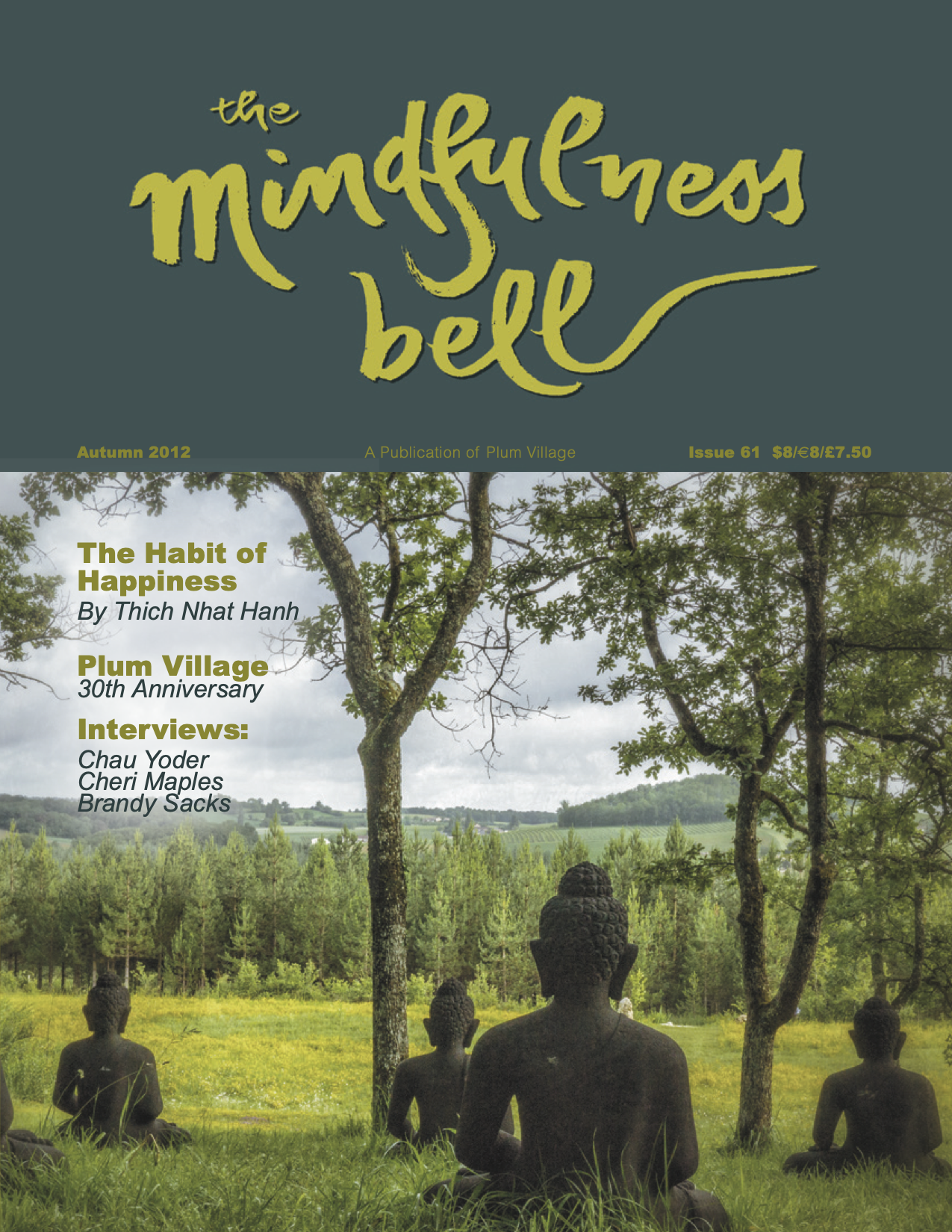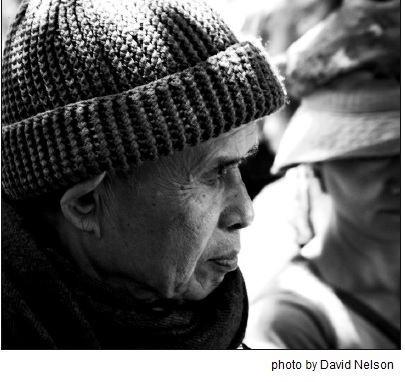
Upper Hamlet, Plum Village
June 19, 2012
Good morning, dear Sangha. Today is Tuesday, the nineteenth of June 2012, and we are in the Still Water Meditation Hall, Upper Hamlet. This is our nineteenth day of the twenty-one-day retreat.
Sitting here, I can hear the sound of the rain. I know that I’m with my Sangha, sitting together, enjoying this present moment.

Upper Hamlet, Plum Village
June 19, 2012
Good morning, dear Sangha. Today is Tuesday, the nineteenth of June 2012, and we are in the Still Water Meditation Hall, Upper Hamlet. This is our nineteenth day of the twenty-one-day retreat.
Sitting here, I can hear the sound of the rain. I know that I’m with my Sangha, sitting together, enjoying this present moment. With mindfulness, this moment must be a happy moment.
The practice of non-thinking is the secret of success in meditation. When thinking settles in, you lose the first impression of contact. You do not have much chance to be in the here and the now, and to be in touch with what is in your body and around you. Instead, just become aware of contact and feelings. In this way you can be in touch with the elements of nourishment and healing available in your body and in the environment, both physical and mental.
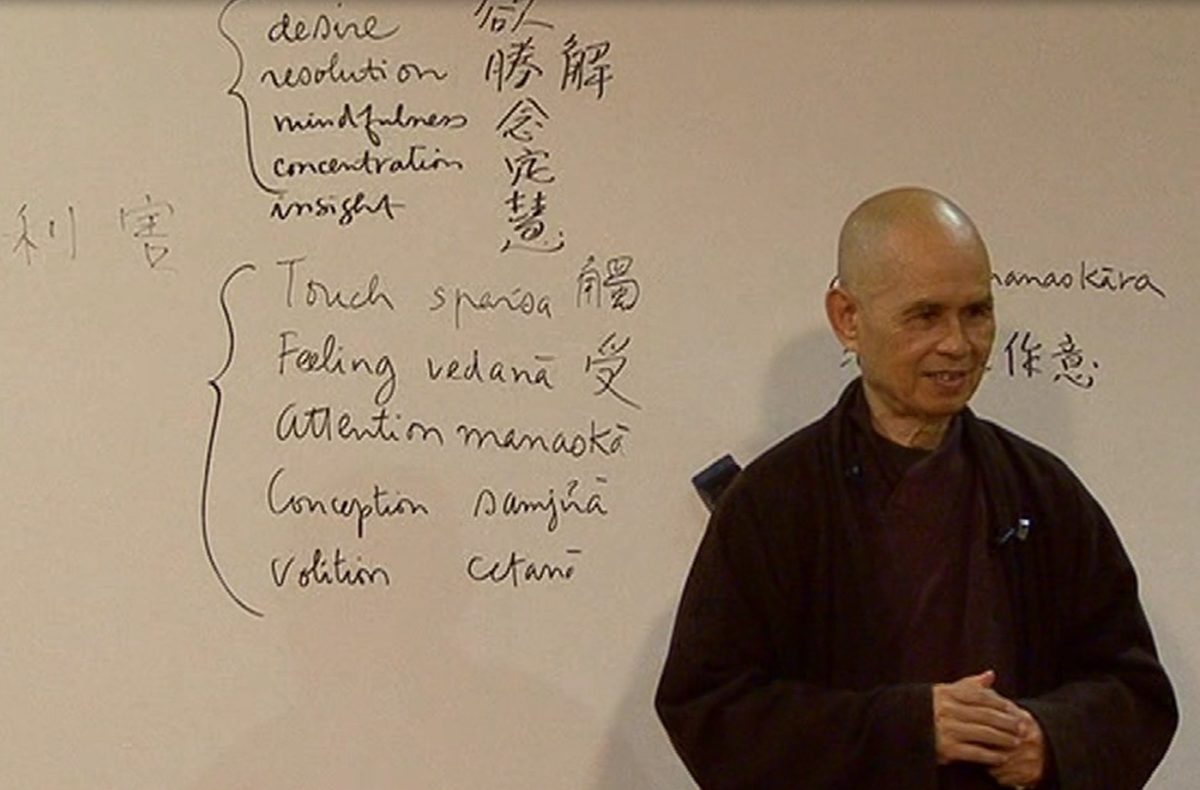
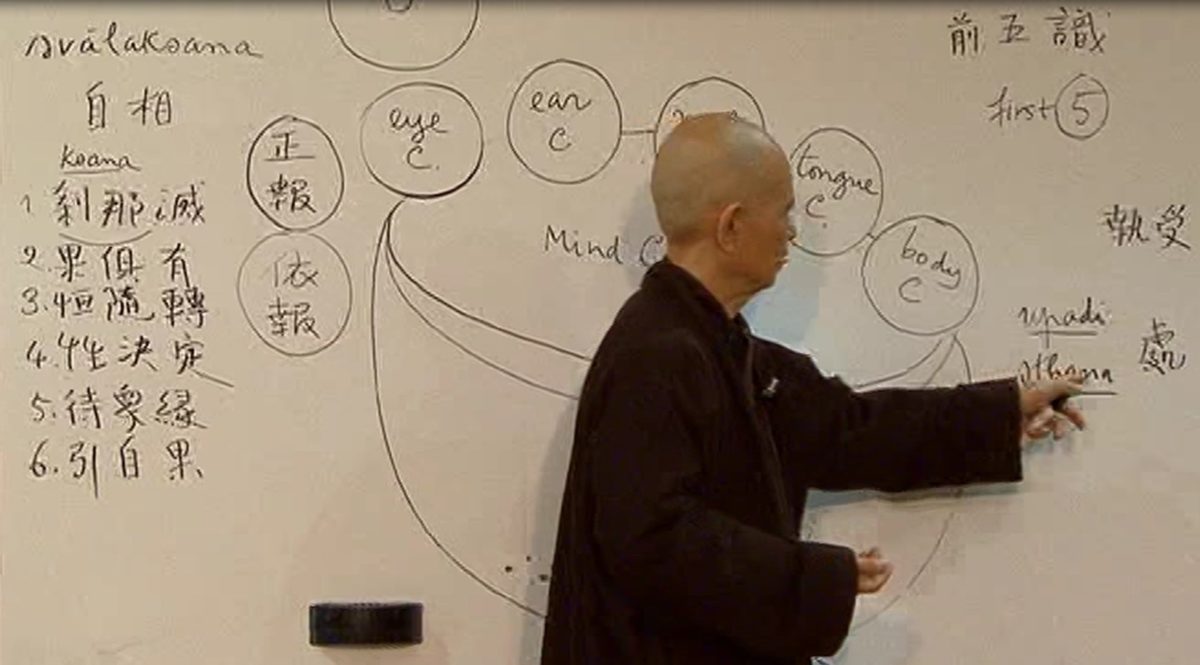
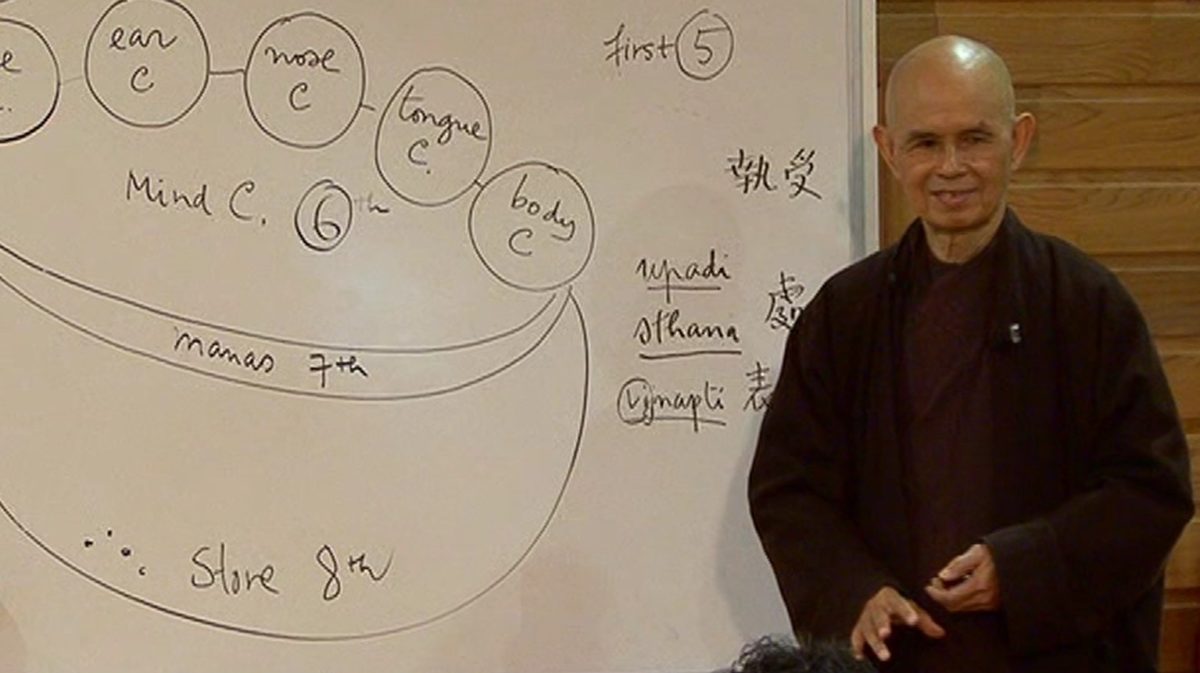
The Universal Mental Formations
There are five mental formations called universal. They are present in every consciousness, in every mental formation.
The first one is touch, mental contact. Sparsha. When eyes and an object come together, there is contact between them, producing eye consciousness. Eye consciousness begins with contact. So mental contact is the first thing that manifests as a perception. Organ and object bring about consciousness. And consciousness is made first of all with mental contact.
It can be followed right away by feeling: vedana. The feeling may be pleasant or unpleasant or neutral.
The third mental formation is called attention: manaskara. This has the function of drawing your attention to an object. When the bell master offers the half sound, your attention is drawn to that sound. That is manaskara, attention. Several objects of attention may happen at the same time—three, four, a dozen—but you’re free to choose one object to bring your attention to.
And with mindfulness you can make a good choice. Instead of listening to another sound, you’re listening to the bell. Breathing in and breathing out, just focus your attention only on the bell. Listening to the bell can help you to create the energy of concentration that can help you to calm down the body and the mind. So that kind of attention is good in nature. It’s called appropriate attention. You choose to focus your attention on something that is wholesome, that will be of benefit. A good practitioner always practices appropriate attention. The Sanskrit word is yoniso manaskara.
But when we allow our attention to go to objects that do not benefit our peace and practice, it’s called inappropriate attention. It’s called ayoniso manaskara. So as a good practitioner, mindfulness helps us to focus our attention only on the objects of benefit, and that can come before contact (sparsha) or after contact. After contact, you may see that this is not a good object of attention, and you may change the object of attention. So manaskara can come before sparsha or after sparsha. These five universal mental formations are always present with consciousness, any kind of consciousness. They are a series, and they bring about a perception.
One day we had a retreat in northern California and there was a fire in the mountains. During sitting meditation and walking meditation, we heard the sound of helicopters. When you have been in a war, like the wars in Vietnam, the sound of helicopters reminds you of machine guns, bombs, and death. So it’s not pleasant. But there was no choice to avoid listening, so we chose to practice listening to the sound of the helicopters with mindfulness. With mindfulness, we can tell ourselves that this is not a helicopter operating in a situation of war. These helicopters are helping to extinguish the flames. With mindfulness, our unpleasant feelings were transformed into pleasant feelings, into feelings of gratitude. Mindfulness can transform everything.
When the feeling is pleasant, you stop all thinking and just become aware of the feeling. Like the pleasant feeling of walking barefoot on the beach, feeling the sand between your toes. Walking on the beach, you can be very happy, if you are able to let go of thinking of this or that.
The fourth universal mental formation is perception. What you are in touch with, what you are feeling, appears in your mind as a sign that suggests a name, like: flower. This is to have an idea about the object of your feeling. When this happens, bring your mindfulness to that perception, because it might be a wrong perception, like mistaking a piece of rope for a snake. Wrong perception is always possible, and can bring about fear, anger, irritation, and so on. Mindfulness can help you avoid wrong perception. The intervention of mindfulness is very important on the path of thinking, on the path of feeling.
The fifth universal mental formation is volition, cetana, resolution, intention. You have the concept, the idea, the perception of the object of your contact. You want to decide whether to possess it or to push it away. This is a decision, an intention, to accept or reject.
A New Neural Pathway
These five mental formations are always together. They form a neural pathway that can lead to either suffering or happiness. In your brain, there are many neural pathways that you are used to traveling on. For example, when you come in contact with something that habitually triggers a feeling in you, like the feeling of anger, your frequent traveling on that neural pathway turns it into a habit—the habit of suffering. With the intervention of mindfulness, you can erase that neural pathway and open up another pathway that leads to understanding and happiness.
Suppose you are reaching for a big piece of cake. Because you have learned mindfulness, suddenly your awareness helps you to ask, “Why am I reaching for the cake? I’m not hungry.” You may have some worry, some anxiety, some irritation, and you reach for something to eat to forget, to cover up the irritation in you. That becomes a habit because a neural pathway in your brain has been created for it. As a practitioner, you have to change the neural pathway to change this pattern of suffering. You should allow mindfulness and concentration to intervene so you are not the victim of that suffering.
Suppose you are in a discussion group and you have a chance to speak about your suffering. You may express your suffering in a way that will make you continue to suffer, like you have in the past. Or you may choose another way. You know that brothers and sisters in the Dharma are listening, trying to help you recognize and embrace the suffering so that you can heal and transform. While speaking, you use mindfulness and concentration in order to share. Your way of sharing changes, and after having shared, you suffer less. Otherwise, sharing in the old way, you are just rehearsing your suffering.
With mindfulness and concentration intervening in the process of perception, a new neural pathway is created that does not lead to suffering. Instead it can lead to understanding and compassion, and happiness and healing. As a good practitioner you know how to make a new pathway in your brain. Our brains have the power of neural plasticity; they can change. Old neural pathways can disappear and new ones open so that you have access to happiness and compassion.
Suppose someone says something that angers you. Your old pathway wants to say something to punish him. But that makes us victims of our habit energy. Instead, you can breathe in and say, “Unhappiness is in me, suffering is in me, anger is in me, irritation is in me.” That is already helpful, recognizing your feelings and helping you not to respond right away. So you accept that anger and irritation in you, and smile to it. With mindfulness, you look at the other person and become aware of the suffering in him or in her. He may have spoken like that to try to get relief from his suffering. He may think that speaking out like that will help him suffer less, but in fact he will suffer more.
With just one or two seconds of looking and seeing the suffering in him, compassion is born. When compassion is born, you don’t suffer any more, and you may find something to say that will help him. With the practice, we can always open new neural pathways like that. When they become a habit, we call it the habit of happiness.
During the winter retreat, Thay stayed in Upper Hamlet for three months. Every morning, when he first got up, he washed his face. The water was very cold. Thay usually opened the tap so the water came out drop by drop, and he put his hand under the water faucet and received the feeling of cold water. It helped to make him more awake. It was very refreshing. He took some of these drops of water and put them in his eyes and felt the refreshment in his eyes. He enjoyed the washing and did not want to finish quickly. He did not have to think. He wanted to be fully alive, so he took time to enjoy the pleasure of the water.
Mindfulness and understanding helped him to see that this water has come from very far away. From up in the mountain, from deep down in the earth, it comes right into your bathroom. When you develop the habit of being happy, then everything you do, like serving yourself a cup of tea, you do in such a way that it creates joy and happiness.
When Thay put on his jacket and walked, he enjoyed every step from his hut to the meditation hall. He always got in touch with the moon or the stars or the fresh air. To be alive and to be walking on this small path is a great joy. To go to the meditation hall and sit with the brothers is a great joy. So every moment can be a moment of happiness, of joy.
If you have depression, if you have some problem with your mental health, the practice of mindfulness, concentration, and insight will help stop you from traveling the same old neural pathways. You open a new path, a path of happiness. Focusing on your suffering is not the only way to heal. Instead, you focus on the non-suffering side that is in the here and the now.
You have many good seeds of happiness and joy in you. You have the seed of compassion, of understanding, of love in you, and you practice in order to get in touch with appropriate attention, stopping your thinking, enjoying the pleasant feeling that is possible in the here and the now. You recognize the many conditions of happiness that are here, in order to make this moment into a pleasant moment. This is possible. While you are doing so, the healing takes place. You don’t have to make any effort because you have the habit of happiness. All of us have the capacity to be happy. Suffering is not enough!
The Five Particular Mental Formations
After you have studied the five universals, you may like to learn about the five particular mental formations, which are: desire, resolution, mindfulness, concentration, understanding/insight. Chanda, adhimoksha, smrti, samadhi, prajna.
The first, desire, is intention. Intention can be positive or negative. Our good intention is our desire to practice, to open new neural pathways, to create happiness. I want to transform suffering, and I know ways to do it. Our resolution is our determination, our confidence that this is what we want. I want to practice, to change myself, to cut off the source of nutriments that lead to suffering. I want to consume only what is good for my mental and physical health. Mindfulness, concentration, and insight are the energies that develop neural pathways leading to compassion, understanding, and happiness.
Eight Levels of Consciousness
The first level of consciousness is eye consciousness. Form is the object of eyes. When eyes and form encounter each other, it brings about eye consciousness, sight. Eye consciousness always has contact, attention, and feelings, because any consciousness has the five universals within it. They happen very quickly, maybe in less than one millisecond.
The second through the fifth consciousnesses are: ear consciousness, nose consciousness, tongue consciousness, and body consciousness. Body and touch, tongue and taste, nose and smell, ear and sound, eyes and form. These consciousnesses are a kind of flow; their nature is a continuum, always going through birth and death.
It’s like the flame of a candle. We have the illusion, the false perception, that it is one flame, but instead there is a succession of millions of flames together without interruption. When someone draws a circle with a flaming torch, you may see a circle of fire. But it is an optical illusion. When the movement is done very quickly, you have the impression that there is a whole circle of fire instead of just one flame.
Consciousness has the nature of cinematography, with one image following another, giving the impression that there is something continuous. So all the five consciousnesses operate like that. When you see an elephant walking, there is a succession of images of the elephant, subject and object always changing. These five consciousnesses can stop operating and manifest again when there are the right conditions. They are not continuous like other consciousness. When you go to sleep, maybe three, four, or five stop operating altogether.
According to Buddhist teaching, when they operate alone without mind consciousness, they might have the opportunity to touch the Ultimate. There’s no thinking. The first moment of touching and feeling can help these five consciousnesses touch the ultimate, touch reality. That is called in Sanskrit pratyaksha. There is direct contact, with no discrimination or speculation. But when the five collaborate with mind consciousness, then the thinking, the discrimination, the speculation settle in and they lose contact with the ultimate, with reality.
The sixth is called mind consciousness. It can be interrupted also, if you fall into a coma, or sleep without dreaming, or enter a meditation called no thinking, no perception. If you dream while sleeping, your sixth consciousness still operates, but it does not get the form, the sound, etc. from these five, but from the eighth, the store consciousness. The store consciousness contains the seeds of everything, so the world of dreams is created from store consciousness.
All the consciousnesses manifest from the base, from the seeds in the store. The seed of eye consciousness gives rise to eye consciousness. The seed of nose consciousness gives rise to nose consciousness. Object and subject arise at the same time.
The seventh is manas, the ground for the sixth to lean on in order to manifest. Manas has a wrong view about self. It is always seeking pleasure and trying to avoid suffering. Manas ignores the goodness of suffering and the dangers of pleasure seeking. Manas ignores the law of moderation. A practitioner should try to instruct manas to transform wrong views concerning self. We have to instruct manas that there is a lot of danger in pleasure seeking; that we shouldn’t try to run away from suffering because if we know how to make good use of suffering, true happiness will become possible. That is the work of meditation.
Mind consciousness with mindful concentration can help open up a new path in store consciousness. Every action that we have performed is preserved by store consciousness. Any thought we have produced today or yesterday, whether in the line of right thinking or wrong thinking, is always stored. Nothing is lost, and it will come back at some point as retribution.
Store consciousness receives information, receives action, and processes it and allows it to mature, to ripen. Maturation can take place at every moment. The seeds of information can manifest on the screen of mind consciousness. The store can be compared to a hard drive, which maintains and stores information. But the information on your hard drive is static; it’s not alive, while all the seeds in store consciousness are alive and changing every moment, going through birth and death, renewing all the time; they are living things.
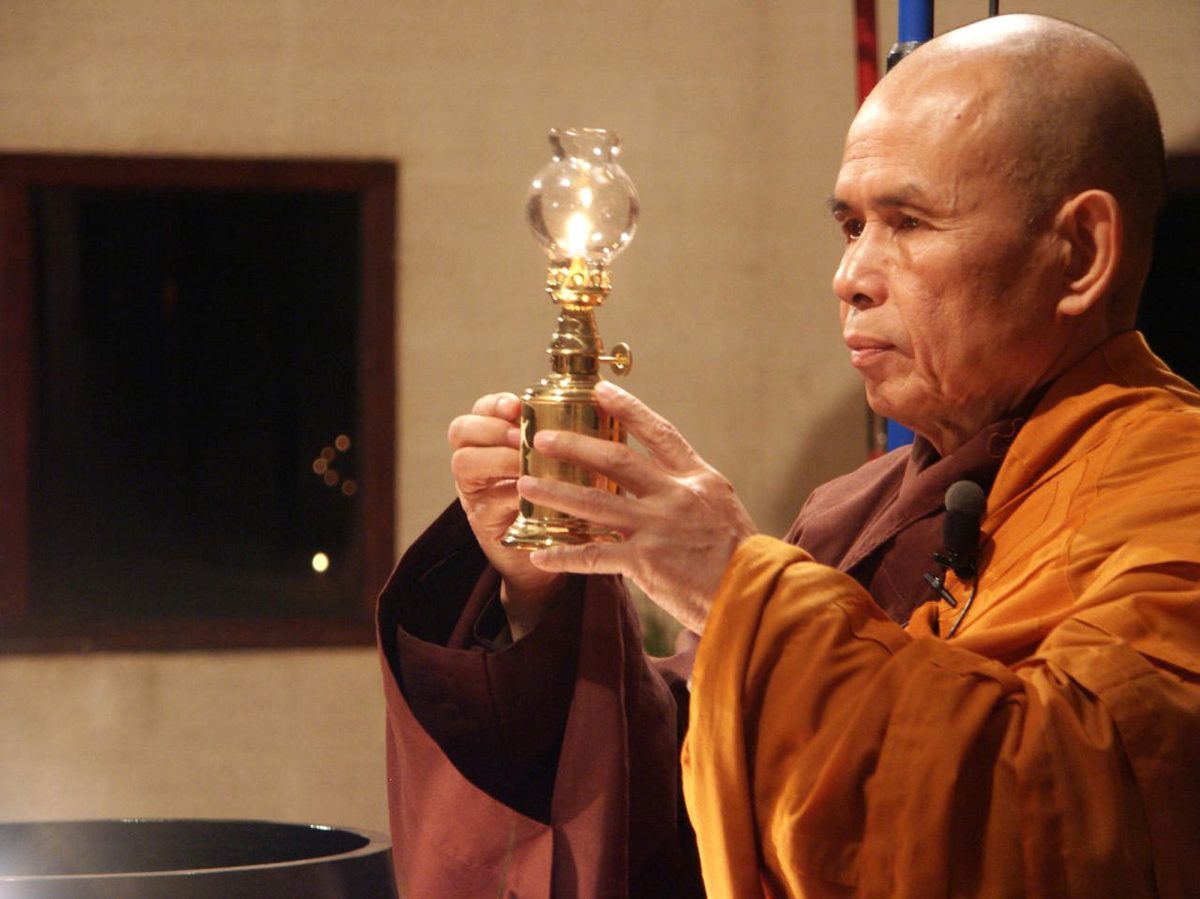
Characteristics of Seeds in Store Consciousness
The bija, the seeds, have characteristics. The first characteristic of a seed is in Sanskrit kshanakarma. It means going through birth and death every moment, cinematographic, always changing, always evolving. Not like the information you store in your computer that stays the same. They are alive, growing, maturing. Their nature is instantaneous (Sanskrit: kshana); it means they only subsist a very short unit of time.
The second aspect of the seeds is in Sanskrit sahabhu. It means that the seed of a mental formation and a mental formation co-exist, serving as cause and effect for each other. They are always together like the left and the right. For example, cause and effect manifest at the same time. Like subject and object, left and right, above and below.
The third aspect of seeds is in Sanskrit bhavangasrota. It means it forms a continuous series. It engenders its own fruit and seeds, again and again. It makes a continuum. It is not a static object; it is a flow. It has its own nature: a seed of corn manifests only as a corn plant. The seed of anger has anger as its nature; you cannot mix it with the seed of compassion.
The fourth aspect of seeds is in Sanskrit vyakrta. It means their nature as wholesome, neutral, or unwholesome is determinate. Every thought, word, or action that you perform can be classified either as neutral, wholesome, or unwholesome.
The fifth characteristic is that seeds are always ready to manifest when conditions are right. The manifestation of a seed can be helped or blocked by other conditions.
The sixth nature of seeds is that seeds always bear fruit. A seed brings about its own fruit. That’s the law of retribution. A good act will bring a good result. Happy, compassionate speech will bring a good result. So the seed of corn only manifests as a plant of corn, and not something else.
Retribution
Store consciousness operates in a way that is not known to mind consciousness. It’s difficult for mind consciousness to see clearly how store consciousness operates. Store consciousness has the duty to maintain, to hold these seeds. Store consciousness has the ability to receive and preserve every act, whether it is speech, a thought, or a physical action.
We continue as a body, as a series of consciousnesses, because store consciousness has the capacity to hold that for us. What we perform as karma, as action, through our thinking and speaking and acting, will always have retribution, and retribution can be seen in the here and the now. Your body, your feelings, your perceptions are a certain way because you have acted in a way that will bring those results. So that is the fruit, the retribution, of your action. The state of your body, the state of your mind, and the state of your environment are the results of your action.
There are two kinds of retribution. The main retribution is your body and mind, the results of your action in the past. You are your action; you are your karma. You are the way you are because you have performed the karma that has led you to this state of body and mind.
The other aspect of retribution is the environment. The environment is you. It’s you who have created that environment because of your karma, your action. There is collective karma and individual karma. Both you and the environment are the fruit of your action, are your retribution. Store consciousness has the power, the duty, to ripen and to manifest the fruit of your action.
Vijnapti has many meanings. The first meaning is to manifest. The seeds of store consciousness manifest in body and mind and environment. You have not been created by a god; you are a manifestation from your own action. You have not come from the realm of non-being into the realm of being. You will not go from the realm of being into the realm of non-being. You have not been created; you are only manifested.
To manifest in this form, and then to manifest in another form, and then in another form, is like the cloud. Now it is a cloud, later on it will be rain. Later on it will be tea or it will become ice cream. There are many manifestations of the cloud. You are like that cloud, and you can choose a path of transformation that you like, that is beautiful. So vijnapti is manifesting as consciousness, as body, as environment. In Sanskrit, all words or nouns that have the “vi” prefix have to do with consciousness. “Vi” means to distinguish, to perceive.
So to manifest as body and mind and environment, and to perceive that body, that mind, that environment, that is vijnapti. In Buddhism there is a school of thought called vijnaptimatra, meaning manifestation only, no creation, no destruction. There is only manifestation. Manifesting from the seeds, from consciousness.
The Light of the Candle
We conclude this Dharma talk with the image of a candle that emits light. Light is an action of the candle. Light is the candle itself. Here we also have another candle that emits light. The candle receives its own action, because the light emitted by one candle shines upon the other candle. What you do has an effect on yourself and has an effect on another person. There are other candles that are close to you; not only do you affect yourself, but you affect the next candle. So here you see the light of this candle, but there is the participation of the other candle also. If you analyze this zone of light, you see this is the light emitted by this candle, but also some of it has been emitted by the other candle.
Imagine there are multiple candles, and one shines in every other candle. You can think in terms of force fields. Subatomic particles can be seen as energy, and they exert influence on other atoms, other subatomic particles. The candle and the light of the candle are the same. We are the same. We and our action are the same. We are only our action. Force fields are like that. Everything is made by everything else. The one is made by the all, and looking into the one, we can see all. Looking into our rose, we see the whole cosmos in it.
You can see that everywhere there is both collective light and individual light. In fact, you can no longer distinguish between the collective and the individual, to the point that you can eliminate the notion of collective and individual, so that you can be free.
Consciousness is like that. The question you may ask is whether everyone has individual store consciousness. Think of the candle, think of our suffering. Our suffering is made of non-suffering elements. Our suffering carries the suffering of our father, our mother, our ancestors, and of the world. So you cannot say that it is individual suffering; you cannot say that it is wholly collective suffering. They inter-are. So interbeing is a good term to describe everything.
TRANSCRIBED BY GREG SERVER.
EDITED BY BARBARA CASEY AND SISTER ANNABEL, TRUE VIRTUE.
Further Reading on Buddhism and Science
Click the links below to read the following articles on Buddhism, science, and mathematics:
- While attending “The Sciences of the Buddha” retreat in Plum Village in June, OI member Paul Tingen was encouraged by a few monastics to write down some of his insights into the parallels between new discoveries in neuroscience and our practice. The result was an essay called “Using Mindfulness to Rewire the Brain: How the Insights of Neuroscience Can Aid Our Practice.” It describes how mindfulness practice and the insight of neuroplasticity can help us rewire our brains and alleviate habitual patterns of suffering.
- “Seven Interbeings” is an article written by Tetsunori Koizumi, Director of the International Institute for Integrative Studies, in response to Thay’s inspirational Dharma talks given during the June 2012 retreat, “The Sciences of the Buddha.” The article demonstrates how Thay’s innovative concept of interbeing is consistent with some fundamental relational principles of mathematics.


